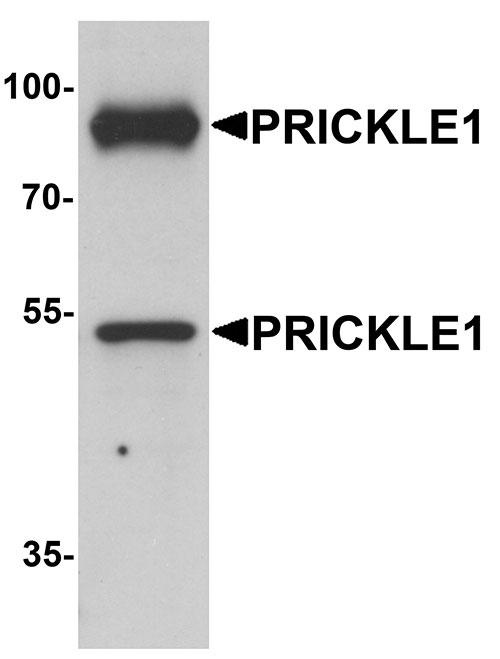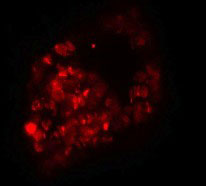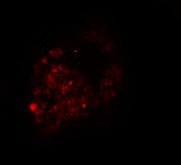PRICKLE1 Antibody
- SPECIFICATION
- CITATIONS
- PROTOCOLS
- BACKGROUND

Application
| WB, IF, E |
|---|---|
| Primary Accession | Q96MT3 |
| Other Accession | NP_694571, 222136684 |
| Reactivity | Human, Mouse, Rat |
| Host | Rabbit |
| Clonality | Polyclonal |
| Isotype | IgG |
| Calculated MW | Predicted: 46, 91 kDa Observed: 52, 90 kDa |
| Application Notes | PRICKLE1 antibody can be used for detection of PRICKLE1 by Western blot at 1 µg/mL. Antibody can also be used for immunofluorescence starting at 20 µg/mL. For immunofluorescence start at 20 µg/mL. |
| Gene ID | 144165 |
|---|---|
| Target/Specificity | PRICKLE1; Multiple isoforms of PRICKLE1 are known to exist. PRICKLE1 antibody is predicted to not cross-react with other PRICKLE protein family members. |
| Reconstitution & Storage | PRICKLE1 antibody can be stored at 4℃ for three months and -20℃, stable for up to one year. As with all antibodies care should be taken to avoid repeated freeze thaw cycles. Antibodies should not be exposed to prolonged high temperatures. |
| Precautions | PRICKLE1 Antibody is for research use only and not for use in diagnostic or therapeutic procedures. |
| Name | PRICKLE1 |
|---|---|
| Synonyms | RILP |
| Function | Involved in the planar cell polarity pathway that controls convergent extension during gastrulation and neural tube closure. Convergent extension is a complex morphogenetic process during which cells elongate, move mediolaterally, and intercalate between neighboring cells, leading to convergence toward the mediolateral axis and extension along the anteroposterior axis. Necessary for nuclear localization of REST. May serve as nuclear receptor. |
| Cellular Location | Nucleus membrane. Cytoplasm, cytosol. Note=A smaller amount is detected in the cytosol |
| Tissue Location | Expressed at highest levels in placenta and at lower levels in lung, liver, kidney and pancreas. Expressed in thalamus, hippocampus, cerebral cortex, and cerebellum (in neurons rather than glia). |

Thousands of laboratories across the world have published research that depended on the performance of antibodies from Abcepta to advance their research. Check out links to articles that cite our products in major peer-reviewed journals, organized by research category.
info@abcepta.com, and receive a free "I Love Antibodies" mug.
Provided below are standard protocols that you may find useful for product applications.
Background
PRICKLE1 Antibody: PRICKLE1, also known as RILP or EPM1B, is a Disheveled-associated protein that serves as a nuclear translocation receptor for REST/NRSF and REST4 (1, 2). It contains three N-terminal LIM domains and three C-terminal nuclear localization signals. It localizes to the cytoplasm, as well as to the nuclear membrane and expressed at higher levels in placenta. PRICKLE1 is a negative regulator of the Wnt / beta-catenin signaling pathway and is a putative tumor suppressor in human HCCs. Defects in the gene encoding PRICKLE1 are associated with autosomal recessive progressive myoclonic epilepsy.
References
Katoh M and Katoh M. Identification and characterization of human PRICKLE1 and PRICKLE2 genes as well as mouse Prickle1 and Prickle2 genes homologous to Drosophila tissue polarity gene prickle. Int. J. Mol. Med. 2003; 11:249-56
Shimojo M and Hersh LB. REST/NRSF-interacting LIM domain protein, a putative nuclear translocation receptor. Mol. Cell. Biol. 2003; 23:9025-31
Chan DW, Chan CY, Yam JW, et al. Prickle1 negatively regulates Wnt/β-catenin pathway by promoting Disheveled ubiquitination/degradation in liver cancer. Gastroenterology 2006; 131:1218-27.
Tao H, Manak JR, Sowers L, et al. Mutations in prickle orthologs cause seizures in flies, mice, and humans. Am. J. Hum. Genet. 2011; 88:138-49.
If you have used an Abcepta product and would like to share how it has performed, please click on the "Submit Review" button and provide the requested information. Our staff will examine and post your review and contact you if needed.
If you have any additional inquiries please email technical services at tech@abcepta.com.













 Foundational characteristics of cancer include proliferation, angiogenesis, migration, evasion of apoptosis, and cellular immortality. Find key markers for these cellular processes and antibodies to detect them.
Foundational characteristics of cancer include proliferation, angiogenesis, migration, evasion of apoptosis, and cellular immortality. Find key markers for these cellular processes and antibodies to detect them. The SUMOplot™ Analysis Program predicts and scores sumoylation sites in your protein. SUMOylation is a post-translational modification involved in various cellular processes, such as nuclear-cytosolic transport, transcriptional regulation, apoptosis, protein stability, response to stress, and progression through the cell cycle.
The SUMOplot™ Analysis Program predicts and scores sumoylation sites in your protein. SUMOylation is a post-translational modification involved in various cellular processes, such as nuclear-cytosolic transport, transcriptional regulation, apoptosis, protein stability, response to stress, and progression through the cell cycle. The Autophagy Receptor Motif Plotter predicts and scores autophagy receptor binding sites in your protein. Identifying proteins connected to this pathway is critical to understanding the role of autophagy in physiological as well as pathological processes such as development, differentiation, neurodegenerative diseases, stress, infection, and cancer.
The Autophagy Receptor Motif Plotter predicts and scores autophagy receptor binding sites in your protein. Identifying proteins connected to this pathway is critical to understanding the role of autophagy in physiological as well as pathological processes such as development, differentiation, neurodegenerative diseases, stress, infection, and cancer.




